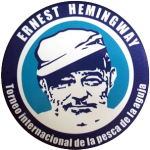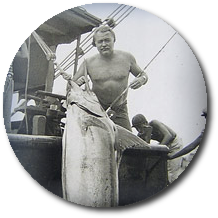Freshwater & Saltwater Fishing
Participate in the 66th Annual Hemingway Billfish tournament in Havana Cuba, June 12-19 2016
 FRESHWATER
FRESHWATERFishermen have the opportunity to fish for achigan, bass, barracuda, carp, liseta, snook and tarpon in Cuba.
Fishing is allowed all year long in the country’s rivers, lakes and reservoirs. The best bass catches occur during the months when the average temperature ranges from 21 to 22ºC (69 and 72ºF).
Every February, Horizontes organizes the annual International Bass Fishing Tournament, an event that has already attracted many fishing enthusiasts.
Several hotels are located within a short distance of reservoirs, rice paddies, swamps, and the mouths of rivers, those unspoiled landscapes that serve as hunting and fishing reserves.
Freshwater fishing locations
 Maspotón Reserve, Pinar del Río
Maspotón Reserve, Pinar del Río
In Maspotón it is possible to fish at the mouth of theCarraguao or Los Palacios rivers, which teem with species such as tarpon, bass, barracuda, liseta, and others. Fishermen will discover the best natural conditions under which to enjoy their favorite sport. There’s also freshwater fishing in a nearby reservoir called Juventud. Large-mouth bass and tarpon are easy to catch along the coast near the hunting reserve.
Accommodations
Coto de caza Maspotón
Granja Arrocera La Cubana, Los Palacios, Pinar del Rio.
16 air-conditioned rooms in double-cabins accommodation with private baths, along with a restaurant, bar, shop, games room, and poolside bar.
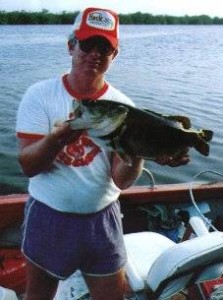 Laguna del Tesoro, Cienaga de Zapata, Matanzas
Laguna del Tesoro, Cienaga de Zapata, Matanzas
Treasure Lake is the largest natural lake in Cuba with a surface area of 16km2. It is located in the Ciénaga de Zapata.
Surronded by a marvelous landscape, visitors will be able to fish for trout, bass, achigan six hours a day. Fishing days may be divided into two fishing sessions if the fisherman so desires.
Accommodations
Hotel Guamá
Cienaga de Zapata, Matanzas
Guamá is unique in the Caribbean. It was designed as a floating wooden city built on twelve islets that are connected through a system of canals over quiet waters. It features indigenous architecture that includes precious woods and dried palm tree leaves. Located on the Treasure Lagoon, the Taino Indian village is a natural-sized sculpture complex, depicting Taino Indians at work.
There are 44 air-conditioned double, triple and quadruple cabins, each with a private or shared bathroom, refrigerator, TV and radio. Other amenities include a restaurant, grill, two bars, a nightclub, a handicraft shop, a poolside bar, a museum (showcasing authentic objects crafted by the Cuban aboriginal population), access to national telephone communication system, medical services, row-boat rental, a speed boat to tour the lagoon or visit other facilities, fishing gear, and specialized guide services.
 Presa Zaza, Sancti Spiritus
Presa Zaza, Sancti Spiritus
This artificial lake, the largest of its kind in Cuba, is located to the east of Sancti Spiritus and features one of the first villas to be built in the 16th century. The lake holds over one-billion cubic meters of water. It is particularly famous for its abundant trout. Some specimens rank among the top of their class in the world. The record for the biggest trout stands at 16.5 pounds.
Accommodations
Hotel Zaza
Finca San José, km 5, Lago Zaza, Sancti Spíritus.
The Zaza offers 65 air-conditioned rooms, each with a private bathroom, satellite television, clock-radio, safe deposit box, and phone. Other amenties include a restaurant, bar on the road to the hotel, snack bar, lobby bar, cafeteria, disco, swimming pool for children and adults, games room, shops, round-the-clock medical services, parking lot, tourist desk, horseback riding, motorcycles for rent, money exchange desk, laundry, fax, photocopying service, taxis, national and international telephone communication links, fishing gear, seafari to Cayo Tabenque, archery, skeets, boat rides on the lake, volleyball and tennis courts, and hunting gear.
 Yariguá, Cienfuegos
Yariguá, Cienfuegos
Bass and carp can be easily angled in the canal of the Yariguá Hunting Reserve.
Accommodations
Coto de caza Yariguá
Finca Palmaritos, Charcas, Cienfuegos
There are 10 double cabins with private baths located within the game preserve. A restaurant, bar, and shop are also located on site.
Lago la Redonda y Laguna de la Leche, Ciego de Avila
The 4 km2 Redonda lake is located 21 km from Morón, in central Cuba. It features the largest concentration of trout per square kilometer in the country. Its prestige as a trout-fishing paradise was consolidated at the beginning of the 1980s, when a group of American fisherman hooked 5,078 trout in only 5 days. Its water is so clear that the fisherman can fully observe the entire catching process.
 Accommodation
Accommodation
Coto de caza Morón
Cristobal Colón No. 41, Ciego de Ávila. Telf.: (53)33-5-4563.
Colonial-style house with its 7 air-conditioned rooms, all with private bath, color TV and minibar. We offer a restaurant serving international cuisine, a grill, bar, swimming pool, currency exchange, safety deposit box and nightclub.
 Presas Porvenir, Muñoz y Santa Ana, Camagüey
Presas Porvenir, Muñoz y Santa Ana, Camagüey
These reservoirs are located very close to Florida, inCamagüey province. They offer excellent conditions all year round for trouts, bass and achigan fishing sessions may last up to 6 hours. The record for the biggest trout fishing stands at 14.5 pounds.
Accommodations
Coto de caza Florida
Carretera Central, km 2, Florida, Camagiiey
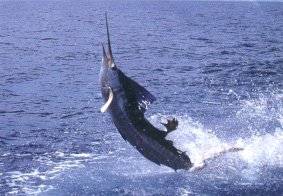 SALTWATER
SALTWATER
Cuba, with its 5,746 kilometers (3,563 miles) of coastline, and its many natural beaches, keys and islets, is the perfect place for anyone who wishes to experience the warm, clear, blue-green sea of the tropical Caribbean.
Cuba’s 70,000 km2 insular shelf is home to a myriad of species, making it a fishing enthusiast’s paradise. Ernest Hemingway, who loved this sport and the exceptional natural conditions in Cuba, immortalized, in his famous novelThe Old Man and the Sea, the International Garfish Fishing Tournament that today bears his name.
Cuban beaches, with their vast vistas of fine white sand and their crystal-clear waters offer a veritable invitation to fish.Cuba is a genuine fishing paradise!
 The long and narrow shape of the island means that Cubans are always close to the sea, and therefore fishing is a natural part of daily life.
The long and narrow shape of the island means that Cubans are always close to the sea, and therefore fishing is a natural part of daily life.
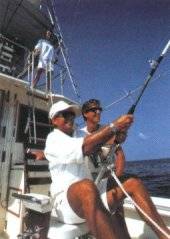 Trolling
Trolling
The favorite technique of all those who are after the really big ones. Marlins abound in Caribbean waters, so your chances of catching one are excellent.
 Bottom fishing
Bottom fishing
In different seasons, you can catch Jew fish, Snappers, Groupers and others.
Fly fishing
Cuba offers an even wider range of fly-fishing possibilities, so you can catch more species year-round. Bonefish and Tarpon fishing are particularly outstanding.
Cuban fishing companies are now establishing fly-fishing centers in zones located within the immense virgin string of keys surrounding Cuba, where the kinds of fish most sought by fly-fishing afficionados abound. And the first of these centers is already operating south of Cayo Guillermo.

Migration cycles
| Barracuda | All year long |
| Bill fish | March, September, October |
| Dolphin | February, March, May, June |
| Marlin (Blue, White, Black) | June, July, August, September |
| Sailfish | May, July |
| Swordfish | January, February |
| Wahoo | November, December, January, February |
Other species have migratory cycles, moving with the marine currents to spawn or to search for food.
Remember
Sailfish, billfish, marlin… the favorite species for deep-sea fishing are more abundant in Cuban waters than anywhere in the world!
